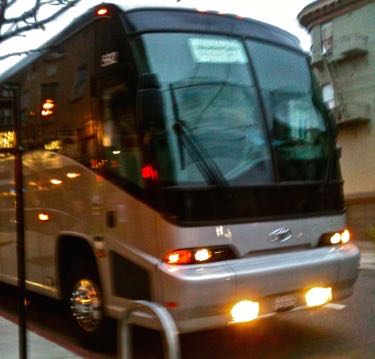
The Google, Facebook, Apple and Yahoo Commuter Buses have become a familiar sight along the Divisadero Street Corridor in San Francisco’s Western Addition. The buses bring new income levels to the Western Addition, increasing the commercial vitality as well as increasing pressure on existing housing, businesses and institutions to serve a newer, moneyed class.
Emblematic of the transformation on Divisadero is the replacement in October of a little-used local market (shown at top) by the second outpost of the incredibly popular Bi-Rite Market — their motto: “In our community, on our table”. Currently successful in the gourmet ghetto of the Mission they are mid-block on 18th Street up from Guerrero Street along with the packed Tartine Bakery, Delfina Restaurant, Pizzeria Delfina, and Bi-rite Ice Creamery. As shoppers arrive on foot, bike and BMW, Bi-rite Market could accurately be described as either harbinger of local food justice or boutique grocery.
The new Bi-rite on Divisadero will locate next to their friends at Nopa (North Of the PAnhandle), another jammed, internationally recognized restaurant which with marketing brilliance branded itself and its neighborhood with the same name, re-envisioning the neighborhood in its own hipster image. Across the street divider Bi-rite faces off with the busy if less healthy options Popeye’s Chicken and Biscuits, Club Waziema Ethiopian Cuisine and Cocktails, Jay’s Cheesesteak, and Acme Burgerhaus. Just 1 block up Da Pitt Bar-B-Que (formerly Brother-in-Law’s) has served up slow cooked barbeque to the community for decades.
December 8, 2011, Forum with Michael Krasny, a local NPR talk show, interviewed Bi-rite founder Sam Mogannam and green grocer Simon Richard regarding Bi-rite’s new book “Eat Good Food“. The discussion spun out during public comment to consider Bi-rite’s influence on neighborhood gentrification including neighborhood character, demographics and rents. Despite protests from the Bi-rite founder, the conflict between the food community and Western Addition’s local black community was clear: healthy, responsible food is great . . . for those who can afford it.
 Caller Alexis formerly of San Francisco, an African-American, who has shopped at Bi-Rite and who also has deep ties to the black community in Western Addition, called in questioning Bi-rite’s claim as a community builder:
Caller Alexis formerly of San Francisco, an African-American, who has shopped at Bi-Rite and who also has deep ties to the black community in Western Addition, called in questioning Bi-rite’s claim as a community builder:
“I keep hearing the word community as if there were no community there before. To me the word community is a new word for privilege. Are you going out to the community that is already there or are you trying to create a new community and ignore the one that is there.”
Bi-Rite’s Sam Mogannam’s impassioned defense:
“18th Street, that block was a pit …. Most businesses had metal bars and grates to protect against robberies that occurred weekly, and it took a business like ours to take those bars down and attract other businesses to come in and synergize and create jobs…. We’re taking over a space that sold cigarettes, Twinkies, Doritos and malt liquor. We’re going to provide fresh foods that’s coming from farms and ranches. We’re taking over a space that had two jobs to one with fifty. We’re going to do what we do best. Listen, respond and provide what the community wants.”
Both speakers were incredibly sincere and heartfelt. Both would agree that Bi-rite is a catalyst for change, whether for the health of a local community or the extinction of a local community.
Questions arise:
-What’s the hidden cost of creating healthy communities?
-Who has the right to define a community and a neighborhood, who belongs, who doesn’t?
-How do we rationalize the oxymoron of a “diverse community”, when “community” implies boundaries and exclusion?
From 1975 to 1995 we watched our local gay friendly neighborhood’s metamorphosis from Eureka Valley to the Castro—gay Zion, tourist Mecca, and street carnival. Changing levels of commercial vitality, rents, street life and demographics appeal to different people and different communities at different times. Sometimes they will serve a local community, and sometimes, perhaps, a global one. Claiming indigenous rights in an urban environment as fluid as San Francisco is hopeless, but we can direct our neighborhoods in positive ways.
Bi-rite’s was not the first book about creating healthy communities.
Just like vegetables, cities and neighborhoods are organic. Proto-urbanist Jane Jacobs recognizes this in the title of her seminal book, The Death and Life of Great American Cities. They are healthy and sustainable when well-balanced, and they are dead and unappealing when artificially preserved or when a single interest creates limited and lop-sided growth inhibiting variety. “Dull, inert cities … contain the seeds of their own destruction and little else. But lively, diverse, intense cities contain the seeds of their own regeneration, with energy enough to carry over for problems and needs outside themselves.”
In the afternoon, the general nastiness of Divisadero’s wind-swept microclimate and its 30 mph rush hour street traffic serves the street well, giving it a scruffy allure that attracts as it rebuffs the local street life huddling at sidewalk cafes or in empty doorways. With the best of intentions Bi-rite joins a multi-cultural neighborhood down at the crossroads.
At Bi-rite we bought the frisée for $1.99 a head and topped it with a poached egg from the local farmer’s market and bacon from our freezer. The frisée was very fresh, local and without bitterness. We tossed it with a vinaigrette of bacon grease, shallots, vinegar and a little sugar.




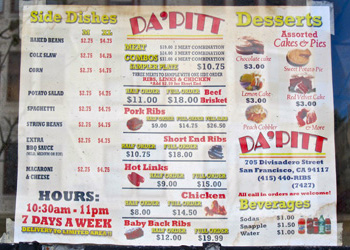
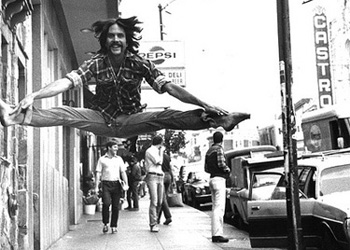
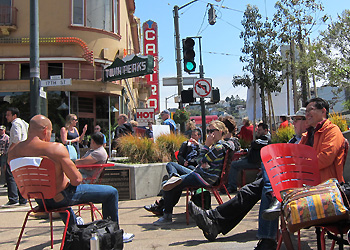
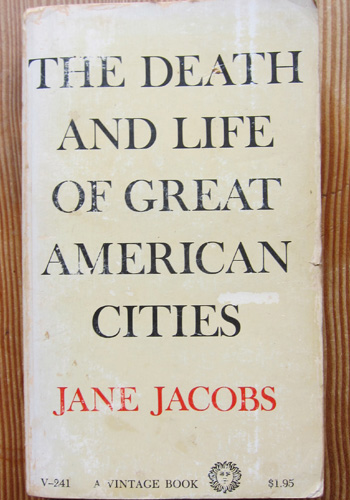



To be honest, that block of Divis doesn’t need Bi-Rite. For fancy pants groceries, we’ve got Falletis just a block over. For ice cream, we’ve got Humphrey Slocombe scooped at Falletis and Three Twins at Green Chile Pies. I’m fine with yupster markets, I just would’ve rather had a good & cheap sushi or Chinese option.
One thing is clear: Moving to Divis will benefit Bi-Rite. Not so sure about the community.
[…] How much impact does a business like Bi-Rite have on a community? Here’s a piece on the upcoming Bi-Rite store on Divisadero: […]
The fact that Bi-Rite is coming in does not mean the plethora of other types of businesses go away. I welcome the diversity of choice and don’t think that additions to an ever changing neighborhood mean that the existing community that has been there for decades is being ignored. New stores are a reflection of the community, not necessarily the change agent.
I’m an “old” Lower Haighter and have seen the onslaught of changes in the Lower Haight that have, indeed, forced the closure, not only of small businesses, but also community institutions like community centers and churches. I have lived in the Lower Haight for over 20 years, and by the reaction to “newbies” in the hood, I am definitely invisible and ignored by them. I’m not a hipster, in my 30s or white. Before the arrival of all the yuppie larva, neighbors on the block took care of eachother. Now if I say hello to newbies on the street they think I’m crazy, or don’t bother to look up from their cell phones.
Thanks for your comment and please keep saying hello to your new neighbors! Neighborhood change is hard to control. But easier than legislated action, neighborly friendliness, particularly between divergent communities with different values will do a lot to breaking down the barriers between them. I wish I could say it will lower rents or return the black population, but, sadly, that’s not the case.
Mr. Mogannam’s defense rings true enough and yet the success of his store depended on the destruction of the existing community. How could they co-exist? He has to attract patrons with financial resources and haute-bourgeois taste. The existing community’s success depends on access to assistance, jobs, business loans, education, public safety, etc., areas where the larger community is failing them. That lack of access is the villain, not gentrification or Bi-Rite. No doubt the community would gentrify itself if it had the resources. This is a great article about an important subject.